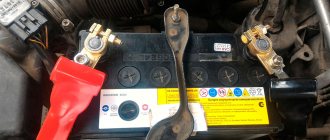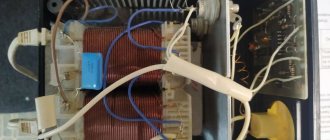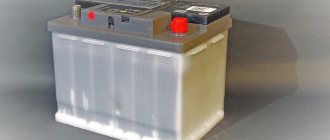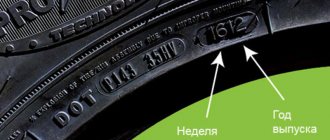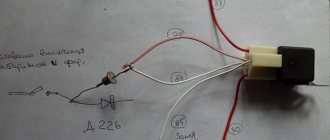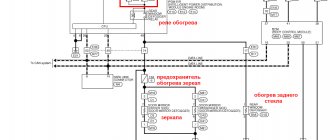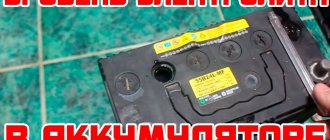Modern batteries, unlike old ones, are not subject to such global repairs as replacing plates, etc. Some models do not even have the ability to add water, let alone anything else. I will tell you what can be done if a crack appears in the battery as a result of an accident or for some other reason. I’ll say right away that if all the electrolyte has leaked out and the battery has stood for a month, then most likely it can be thrown away due to deposits on the plates. You cannot add electrolyte to the old one; this will most likely damage the battery. Almost all battery housings are made of plastic such as >PE
“How to seal a crack in a car battery case?”
Battery cases are made from plastics: polyethylene or polypropylene. Housings for budget batteries are made from the first, and for premium ones from the second.
Polypropylene is less dense than polyethylene, harder, has better abrasion resistance, is more heat-resistant (begins to soften at 140°C, melting point 175°C), and is almost not subject to corrosion cracking.
Both materials are chemical resistant. Concentrated sulfuric acid at room temperature has little effect on them. But prolonged contact with it at 60 °C and above leads to the destruction of polypropylene and polyethylene. It is also undesirable for gasoline to come into contact with the heated battery housing. At high temperatures, aromatic hydrocarbons (gasoline) dissolve the materials in the battery casing.
In some brands of cars, the battery is located in the trunk or interior. This is the best solution for preserving the battery case. In second place in terms of safety are special boxes that protect the battery under the hood. In addition to protective functions, some boxes feature a supply of hot air from the heating system. In winter, such a battery is heated, which makes it possible to better preserve it.
In modern cars, the temperature under the hood in summer reaches 90°C. Usually, for batteries located next to the engine, the bank closest to the engine fails (boils out, overheats). The best way out in this situation is to put a protective casing on the battery, adding to it an improvement in the form of heat-reflecting material. It can be made from the most ordinary solar reflector under the windshield.
Repairing cracks in the battery case
possible by gluing, welding or soldering. You need to solder the plastic of the battery case with the same material from which it is made. A piece of the dust protection strip of the same battery, which covers the dust plugs, will work well for the patch.
It is imperative to prepare the surfaces that will be joined. This is done using sandpaper. Next, remove any fatty residues. For this purpose alcohol is used. Degreasing is a necessary procedure when welding or gluing elements: the results will be much better and the patch will last longer.
The soldering process can be carried out using a regular soldering iron or a special hair dryer gun for gluing plastic.
Fix the patch using glue for polypropylene or using cold welding for plastic according to the instructions for them. Only special types of adhesives can properly glue polypropylene and polyethylene. Soldering method is preferable. Fixing a patch glued with glue or cold welding is done using electrical tape wrapped around the battery body, which will compress the glued elements for one hour.
Important!
Find out why a crack formed in the battery case. For example, if, due to careless removal of the battery from its seat, the connection point with the cover was torn, then the repair will continue the life of such a battery. If the case is cracked as a result of an impact or falling of the battery, you need to make sure that the plates and connections inside the battery are not damaged.
Dear visitors! If you wish, you can leave your comment in the form below. Attention! Advertising spam, messages not related to the topic of the article, offensive or threatening in nature, calling for and/or inciting ethnic hatred will be deleted without explanation.
- Thank you very much for the short and valuable consultation! Happy New Year! Good luck in the future in understanding everything that humanity has created! Best regards, Alik Sukharev.
- No need to drain
- This is the situation. The negative wire got hot, and it burned through the battery, right next to the negative terminal. The electrolyte did not leak. So here's the question. Is it necessary to drain the electrolyte from this can before soldering?
How can I seal a crack in a battery?
- chewing gum, or snot and tears mixed
- bitumen, but it’s better to buy a new one
- just throw it away
- The battery must be disposed of urgently; the fumes generated as a result of operation are very dangerous to health. . From food poisoning to loss of consciousness. . Another accident involving you? ? You need it? ? Don't save money on your battery and your health! !
For modern maintenance-free car batteries, the word repair can only include repairing a damaged case; lead plates in such batteries are not replaced; even manufacturers now do not carry out repairs; they recycle old batteries.If only the case is damaged, then read on: If you really want to repair your battery, then there are several options. Basically, problems with the battery can arise as a result of wear or mechanical stress on the plates, conclusion, you need to change the plates, in principle, from two non-functioning batteries you can assemble one by taking good plates and putting them in one case.
To perform this operation, you will need to carefully cut out a rectangle in the body along the contour of the can from the top, separate the contact jumper holder from the adjacent can, assemble the good plates into the can and install it in its original place with the contact line connected. The contact line can be connected using a lead plate bolted on both sides or soldered, then install the cut out part of the body, glue it or seal it hermetically.
The case is sealed by heat welding, the intended connection is heated until the plastic softens and pressed tightly, wait for 2 to 5 minutes, if the gap is large, then add a strip cut from another battery. By the way, cracks in the battery are sealed in the same way; before sealing the crack, the electrolyte is drained and dried, especially the soldering area. After sealing the crack, if the electrolyte has been drained, then the new jar must be subjected to a double charge and discharge to normalize the performance of the jar being repaired.
In addition to sealing, there are now many different adhesives that reliably glue plastics that work with aggressive media, such as an electrolyte consisting of dilute acid.
In terms of gluing cracks and other damage to the battery casing, we recommend using positive epoxy adhesives, this is a sealant adhesive popularly called cold welding, with its use we achieved good results; acid practically does not corrode it.
To clarify, in order for the glue to stick everything tightly and last for a long time, before applying it, it is necessary to clean the surfaces to be glued from dirt, degrease and dry the surface; for better adhesion, it is advisable to clean the surface with sandpaper. The glue hardens within ten minutes, full adhesion of the surfaces occurs after two hours, you can fill in the electrolyte and do not forget to double charge and discharge the new can.
Repairing a battery, and in particular a cracked case, can be soldered using various methods, the main thing when sealing the case is to slightly melt the crack, this action can be done using a soldering iron. And now about the main thing, if you decide to repair an old battery, the question arises where to get new lead plates, for a sample we barely got a few pieces directly from the factory, the photo is on the device page, if you use plates from an old battery, they have already been exposed to electrolyte and they won't last for a long time. Summarizing all the time spent and the degree of knowledge, we advise you not to get involved with repairing car batteries; it’s easier to buy a new one.
The result of a repair always depends on the determination of the master to achieve the intended effect and his willingness to spend the required amount of effort, money and time. The cost of battery repairs must be determined after a thorough check and diagnosis of the disease. Repairing a car battery with your own efforts is justified if the estimate for its repair is no more than half the price of a similar new product, taking into account that most of the work will be done with your own hands.
Repairing a crack or chip in the case or breaking the integrity of the contacts will cost symbolic costs. For expensive brand models that are shabby, but have retained at least half of the planned resource, battery repairs are usually carried out in car workshops.
If you have the patience and desire to understand the issues of repairing a car battery with your own hands, watch the video:
But it is better to turn to the literature on the maintenance and repair of automotive equipment from the 60-70s of the last century. Don’t be confused by the age of the source - over the last 30-40 years, acid batteries have become more advanced, but the main breakdowns and repair methods have remained the same. Usually the topic - how to repair a car battery - is laid out down to the smallest detail.
How to repair a cracked battery yourself
A hole—a crack in the battery case—is a very negative thing: the electrolyte leaks out, corroding everything in its path, and the power inside the battery drops.
In general, everything is bad: you need to go and buy a new battery. But here comes another moment of truth: what if there is no money?! Then you need to repair the crack in the battery! How? Read below and find out everything. By the way, if you don’t want to bother with repairs, I recommend purchasing a new battery here https://magazun.com/akkumulyatori/. Firstly, if you discover that the battery case is depressurized, you should immediately remove it. But this should be done very carefully, since acid, which easily corrodes metal, will eat your hands without remorse (the author tested it on himself: it really hurts). Therefore, be sure to wear thick rubber gloves, a respirator and goggles: this will protect you from acid. And don't ignore the advice! Acid is like oil in a frying pan: you don’t know exactly how it will behave in a second! After removing the battery from the car, place it on the floor and leave it for now: you should start removing the effects of an acid attack! The acid that is spilled inside the hood remains a very aggressive substance: you can’t wipe it off with a rag. First you need to neutralize the effect of the acid. We remember from the chemistry course that alkali serves as a neutralizer for acids. Where can I get lye? Gentlemen: yes, it is in every home - it’s baking soda. Just sprinkle baking soda on the acidic areas and wait a few minutes. Then take a scoop and remove the neutralized acid. Now we return to the battery again. Lay it on its side and, with some sharp object, lightly scratch the path of the crack. This measure is necessary in order to create adhesion for the substance that will serve as a patch on the battery case. Degrease the treated surface with some solvent or acetone and wipe dry with a rag. Now we move on to making the patch mixture. Take epoxy glue and mix it with some of the sawdust that you sawed when cleaning the crack with a sharp object (knife, nail, etc.).
The resulting mixture will perfectly close the crack in the battery case. The main thing: evenly distribute the glue with sawdust over the surface of the crack. The patch mixture dries within an hour. Also. as an alternative. You can use a regular soldering iron: move the hot soldering iron along the crack, directing the melting plastic inside the battery.
In general, the soldering iron is easy to understand. Attention: before you begin repairing the housing, all electrolyte must be drained from it. And after the repair is completed, the battery should be filled with new electrolyte and charged. But if you don’t want to repair the old battery, but buy a new one, then you need to select the battery according to its size so that you don’t have to make an extra trip to the store.
Another problem that sometimes occurs with batteries is a broken positive terminal. Of course, the solution to such a problem would seem to be within the capabilities of only service station technicians: welding is indispensable. But this is only at first glance. Take a drill and a bit. Drill a hole through both terminal elements to be fastened together. Hole diameter 4 mm.
Now take a conductive lubricant and treat the joining surfaces of the elements. This way you will reduce the resistance of the joint and protect it from the oxidative process. And then you can fasten the split contact (terminal) with a regular self-tapping screw! In general, during the restoration process you will understand everything yourself: if you have the desire.
Soldering aluminum radiators
For aluminum devices there is a special repair procedure that involves soldering the damaged area. You need to start by removing the radiator from the car, after which all remaining liquid is drained. The tank is washed with clean water and dried so that not a drop of moisture remains. Then you should carefully evaluate the condition of the tank, find all possible cracks and defects. This is done like this:
- take a bath or a large basin of water;
- prepare a pump or compressor;
- close the fitting of the radiator cap, as well as all pipes of the cooling system, but leave the thinnest one and connect the drain pipe;
- put the device in the bath, supply air;
- By the release of bubbles, determine where the defect is located.
The flux is bought in stores for radio amateurs; the packaging will indicate “for soldering aluminum.” You can prepare it yourself from rosin and iron filings (the latter are obtained by processing an iron product with a file). The components are combined in equal parts and heated over a fire. Solder is also bought at the Radio Components store; it should be made of copper, zinc, or silicon.
Soldering is done as follows:
- clean the area of the tank with a file and sandpaper;
- degrease with acetone;
- warm up the joint with a lamp, then place flux there;
- process with a soldering iron;
- apply solder, heat with a soldering iron;
- let the “patch” cool, if necessary, perform a second layer;
- After cooling, remove smudges with sandpaper.
Soldering cannot be used if the leakage is found in the fitting or on massive power parts that carry the load. Soldering will be useless; such a radiator must be replaced immediately.
Car battery repair
It often happens that the battery fails due to non-compliance with operating rules or due to mechanical damage. The main task of the battery is to supply power to all electronic devices of the car.
Battery types
Modern batteries are divided into several types:
Acid-type batteries are used in automotive production. The battery is the most important element for the operation of the car, and its breakdown will not make it possible to continue using the vehicle. The battery breaks down due to improper use or improper maintenance. Its malfunction is conventionally divided into two options:
- mechanical breakdown that can be repaired with your own hands;
- damage to internal elements that cannot be repaired with your own hands.
To put the device in order, you need to understand its design, and only after that you can begin to repair it.
Battery device
The battery consists of a sealed case, into which 6 sections are inserted, they are called banks. The jars contain lead plates with the active mass applied to them. These plates are divided into positive and negative, all of them are arranged alternately. A separator is placed between them, which isolates them from accidental contact.
The plates form blocks, each of which is connected to the bridge using a bridge called a barette. The brackets connect all the banks to the bridge, which has access to the terminals of the car battery. All jars are filled with electrolyte, which promotes the formation of a chemical reaction. The battery is not capable of generating electricity on its own, it is its storage, so a generator is installed in the car.
Manufacturers provide two options for car batteries:
- the first of them is a serviceable one, on the body cover of which there are screw caps for each can;
- the second is maintenance-free, where the housing cover does not have plugs, only a release valve designed to relieve excess pressure.
In the event of a malfunction, only serviceable batteries can be repaired. They can be repaired in case of slight damage.
Malfunctions and methods for their elimination
Several parts of the battery are susceptible to breakdown, namely:
- its terminals, the damage of which consists of excessive oxidation;
- formation of housing cracks, they occur due to poor fastening;
- internal damage to the plates and bridges that connect to the battery terminals.
Almost all of them can be repaired with your own hands and the battery can be restored to functionality. Faults are visible by simple inspection and do not require additional diagnostics. Having examined and identified the breakdown, you can begin repairing the car battery.
Due to weakened contact with the wires, the terminals begin to oxidize heavily. Eliminate oxidation by removing the wires and thoroughly cleaning each terminal.
To do this, take sandpaper and use it to clean the car battery terminals until they are completely shiny.
The crack in the case is repaired using a soldering iron and a piece of plastic.
Before soldering begins, the electrolyte is drained from the battery. Having sealed the crack, the tightness of the battery is checked by pouring distilled water into it.
For reliability, it is worth soldering a piece of plastic over the sealed crack.
Severe internal damage to the plates, such as sulfation and shedding, cannot be eliminated. In mild cases, the battery must be fully charged with a current of 10% of its total capacity. During the procedure, you will need to add distilled water, the level of which should cover the top of the plates.
***
to repair a swollen battery or restore it at home. Modern lithium-ion and lithium-polymer batteries require responsible handling and laboratory repair conditions (usually replacement of chemistry).
It is up to you and me to enjoy your devices with lithium batteries. But keep in mind that you should treat them with caution and understand their internal characteristics.
Write in the comments what led to the battery swelling in your case? For example, in our experience with laptops, this is usually facilitated by constant operation from a power outlet.
Subscribe to VKontakte for news from the world of gadgets, learn about improving their autonomy and progress in scientific research on batteries. Connect with us on Facebook and Twitter. We also maintain a busy blog on Zen and Medium - come check it out.
Vitz RS, NCP-13, (1NZ-FE, MT-5), TRD, Apex`i, KONI, RS-R
– SOLDPremio – NZT240-AEPEK gray reliable goodness ))
How to seal the battery
How to seal the battery. (the hole is about 5x15 mm) I tried this, it fell off
its body is made of such cool plastic that it is impossible to seal it (and even acid). If the hole is below the waterline, then change the battery.
The fact of the matter is that it’s higher, the top edge (corner). On the bumps it little by little splashes out anywhere(
you need to make something like a clamp around the entire case, close the hole itself with a thick rubber band that will be pressed like a rectangular ring around the entire battery
The battery case is usually made of impact-resistant, heat-resistant propylene or polypropylene.
I sealed mine with cold welding and nothing fell off. Both winter and summer have passed. Try a different weld.
I soldered it on the shistik and kept it. A really big soldering iron, which is used to tin radiators.
If the LiPo is over-discharged and won't charge
Computerized chargers check the voltage before starting charging, this is done so as not to explode the supplied, for example, 2S LiPo when the charger is set to 3S. After all, if the 2S is charged to 12.6 Volts, then you get 6.3 Volts per jar, and this is fraught with an explosion (overcharging above 4.2 Volts).
The minimum voltage mark is taken to be 2.9-3 Volts per jar. If you rubbed the drone and the battery died while you were looking for the quadcopter for a couple of days, then it can be restored.
To do this, connect the LiPo to the charger and select “Battery type - NiCd”, you can also select NiMh, turn on the charging and see, as soon as the voltage rises above 3 Volts per cell (6 for 2S, 9 for 3S, 12 for 4S, etc.), stop charge, select the standard charging mode for the battery.
The best thing is to check the battery through the balance connector one by one and charge only the “sagging” can.
As you can see, repairing a LiPo battery is a very simple matter!
Advertisements on NN.RU - Auto
Manufacturing of a broken-type platform with retractable ramps on the GAZ-33023 Gazelle-farmer chassis. Technical characteristics of the tow truck.
Lengthen Gas 331043, 331063 Valdai-farmer for installation of a body 5.1/6.5 m. The chassis is lengthened by increasing the wheel size.
A specialized company for the conversion of trucks produces extensions for man man, iveco and iveco truck tractors.
Lengthen Kamaz under a body 7.5 m Lengthen Maz Zubrenok, Maz under a body 9 m Re-equipment of the chassis of an extended truck.
What material is used in the manufacture of car batteries?
The body of this device is made of plastic. Polyethylene and polypropylene are used for this purpose. The first material is used to make budget batteries. More expensive models are made from polypropylene.
This is due to the high density of the material. Polypropylene is considered harder and has good abrasion resistance. In addition, this material is characterized by high heat resistance. It becomes soft at a temperature of 140 degrees. In this case, the melting parameters reach 175 degrees. The material almost does not suffer from corrosion cracking.
Moreover, both substances are resistant to chemical elements. In room conditions, high concentration sulfuric acid has an unexpressed effect on them. Moreover, prolonged contact with this substance at temperatures of 60 degrees or more provokes destruction of materials.
It is also advisable to prevent gasoline from penetrating into the heated battery case. At elevated temperatures, hydrocarbons provoke dissolution of the casing.
Flux treatment
To prevent subsequent oxidation of the contact, the surface of the battery, cleared of plaque, should be immediately treated with a flux mixture made from ordinary rosin.
If, for example, there are no greasy stains from oils on the phone battery contacts, just wipe them with a soft flannel soaked in ammonia.
After this, you will need to warm up the soldering iron well and solder the contact area with a few quick touches. At this point, preparation for soldering can be considered complete.
Is it possible to solve the problem in the long term?
Before repairing a car battery, it is recommended to establish the reasons that caused cracks to appear in the case. If, due to careless removal of the battery, the fixation area with the cover is damaged, repairs will help increase the life of the device. If damage to the case is caused by a fall or impact of the battery, you should make sure that the plates and other battery elements are intact.
It is advisable to start repairing the battery if the costs are at most half of a new device. It will not be possible to give a second life to the battery. As a result of such repairs, it will be able to work for a maximum of 1.5 years. At the same time, in the winter season the device may fail.
Before starting repairs, be sure to read the safety rules. The electrolyte is a solution of sulfuric acid. This liquid is considered very aggressive. To neutralize it, it is permissible to use soda. It is recommended to carry out any repair work with gloves, glasses, and protective clothing.
Battery repair helps to slightly increase the life of the product. There are several ways to fix cracks in a device. To achieve good results, you should choose the appropriate option and strictly follow the rules of the procedure. Strict compliance with safety requirements is of no small importance.
Source
Operating Instructions
For the repair procedure to be successful, it is important to choose the right method and follow a number of recommendations.
Sealing
Before starting the procedure, it is important to prepare everything you need. To do this you will need the following:
- soldering iron with a flat tip - its power should be 40 watts;
- a fragment of brass mesh with small cells;
- metal scissors.
It is permissible to use a more powerful soldering iron.
But in this case, you should be careful when working. Otherwise, in the areas where the metal mesh is attached, there is a risk of a through hole appearing on the material
It is permissible to remove the brass mesh from the car gas pipeline tube. It is located directly in the tank. This mesh is used in the vehicle's power system and plays the role of a filter. After leveling, it can be used as a reinforcing layer. This will help eliminate the tank leak. If you can’t find a brass mesh, you can use a steel one. This material is sold in construction stores and has an affordable price.
Soldering is considered the most reliable method for eliminating cracks. Plastic melts easily even at relatively low temperatures. Therefore, to carry out the manipulation it is permissible to use an ordinary soldering iron. To solder the tank, you should perform the following steps:
- Place the tank on a flat surface. Moreover, it is recommended to direct the crack upward.
- Heat the soldering iron to operating temperature.
- Cut the metal mesh so that its length and width are slightly larger than the damaged area. Apply the material to the damaged area.
- Using a soldering iron tip, solder the mesh into the plastic. This is recommended to be done along the entire length of the damage.
During the procedure, it is recommended to carefully melt the plastic directly into the crack. Otherwise, it will not be possible to properly deal with the damage. Metal mesh is considered an excellent reinforcing material. However, the patch can only withstand pressure if the plastic layer is uniform.
Sealing
To achieve good results using this method, you must use a two-component composition. To do this, do the following:
- Prepare surfaces. It is recommended to clean them from dirt. To do this you should use acetone.
- Apply glue. The liquid substance is applied in a thin layer to the damaged area. It is recommended to cover this area with welding granules from another bottle. Then cover the surface again with impregnation glue.
- Glue the parts together. The adhesive composition sets almost instantly. Within a few minutes after using the substance, the tank can be returned to its place and filled with liquid.
It is worth considering that the interaction of the liquid adhesive part and the welding granulate causes an exothermic reaction. It is accompanied by the release of steam and heat. Therefore, it is recommended to follow safety precautions.
Welding
Cold welding is considered an auxiliary method that does not provide long-lasting and reliable results. This method helps to achieve temporary fixation, which will ensure comfortable delivery of the vehicle to the service station. For cold welding to produce results, the surface must be cleaned first.
Application of epoxy glue
The use of such a substance is also considered a temporary method. It will not help fix the crack for a long time. To get a good result, the plastic is first cleaned of residual dust, grease, and contaminants.
Acid-resistant adhesive sealant for battery repair
I still agree with Reindeer Breeder - the problems from leaking acid can be much greater than the cost of a new battery. A video about how and with what you can solder a broken battery case, using the example of repairing a new broken one. In terms of gluing cracks and other damage to the battery case, it is recommended to use epoxy adhesives, this is an adhesive sealant popularly called cold welding, when using it we achieved good results, its acid practically does not corrode. Clarification: in order for the glue to stick everything tightly and last for a long time, before applying it, it is necessary to clean the surfaces to be glued from dirt, degrease and dry the surface; for better adhesion, it is advisable to clean the surface with sandpaper. The glue hardens within ten minutes, and full adhesion of surfaces occurs after two hours. There is only one drawback in this repair: mast
Search for data based on your request: WATCH THE VIDEO ON THE TOPIC: how to solder a broken battery
Methods for repairing fuel storage tanks
There are several ways to troubleshoot. Most of them are applicable in extreme conditions, which will avoid spending additional money on.
Installing the patch using a nut bolt and rubber gasket
. First, using available means, you need to expand the hole in the tank to a size that matches the bolt. A washer with a rubber gasket is placed on its narrow part. Then the entire structure is inserted into the hole through the neck. A cuff with a washer is installed on the outside and tightened with a nut.
The rubber must be petrol resistant. Not every driver has such material stored in his car. A camera from any truck will be suitable as a replacement. This patch is considered quite durable. When contacting a service station, you can wait. This method is often used by truckers who spend most of their time on the road. A good patch can last more than five years.
Using Moment glue or any of its analogues to repair damage
. The method is relevant for not very serious damage. To create a patch, you need a piece of dense but pliable fabric soaked in glue. It needs to be pressed firmly to the site of injury and held for a while. After the main gluing, the patch should be treated with nitro paint from the repair kit. This is a temporary measure to allow you to get to the nearest service station.
In the video, repairing a hole in the gas tank:
Temporary replacement of the gas tank with any bottle.
The method is suitable for breakdown of the fuel capacity of carburetor-type cars. A plastic or any other container is filled with gasoline, and a hose running from the gas pump to the fuel tank is immersed in it. The container should be securely secured so that it does not tip over and lead to negative consequences. This method will easily help the driver get out of a difficult situation.
Repairing damage with laundry soap
. The method is considered effective only for superficial problems.
Sealing the crack area with epoxy glue and fiberglass
. The gluing area must be thoroughly cleaned and dried, and the gasoline must be drained. Clean the work area with sandpaper, degrease and dry again. A piece of fiberglass must be glued to the damaged area. After complete drying, apply another patch of the same type. The number of layers must be at least three. When gluing the last layer, you should use a plasticizer, which can be aluminum powder.
Repair of plastic gas tanks and metal gas tanks using cold welding
. The best fight against holes. Damage is removed using epoxy resin. The first stage of work is sanding the surface with sandpaper. Then, in a separate container, mix the epoxy resin with the hardener until a homogeneous mass is obtained. If heating is required, the container can be placed on the engine. This method also uses a fabric patch. Saturate it generously with the resulting mixture and apply it to the hole in the fuel tank. Let dry thoroughly. This patch is very strong and can last quite a long time.
DIY car battery crack repair
Some materials in this section may contain information prohibited for children. Full version. The main auto forum. How to seal the hole on the battery? Repair, maintenance, tuning. Show comments. Andrey Ryrikovich March 31 Copy link to message.
A hole was formed as a result of the crookedness of the installer. The hole is on the corner of the battery, on the side, just above the middle. Should I fuse it with a soldering iron and mesh or is there some kind of miracle glue? Or maybe coat it with glass sealant? I don't want to buy a new one, this one is fresh. Andrey Ryrikovich. BCT March 31 Lord Elektronoff March 31 Lord Elektronoff.
Gogi March 31 Throw it out and buy a new one Or is it exclusive? Then solder the patch. Would you recommend, pyromaniac, a patch and a soldering iron.
But I would throw it away. Adad March 31 Cold welding? Andrey Ryrikovich wrote: A hole was formed as a result of the installer's cranky hand. Give him this one, let him buy you a new one. Screw12 March 31 The shavings are made of the same material as the battery case. Perhaps I was just guessing. Cherdak March 31 Dokhtur March 31 If PE hadn’t gotten into the topic, then it would have been possible. And now just to throw away, damn it:. Screw12 wrote and the old new body is not the same as before, you need to look at what it is made of Jeaman March 31 Thermal glue, sold together with the gun at Fix Price, or melted.
Fierce Harry March 31 Dental technicians have plastic to repair dentures. It grabs tightly. I took it from medical equipment. I have been using it at home for many years. I wrapped a self-tapping screw with an elastic band in the battery with super glue, after a couple of weeks it wouldn’t start, I couldn’t find the self-tapping screw, all the acid leaked out, I took one battery out of the handle and also made a bolt, cut a thread in the hole, tightened it from the terminals, had no problems for three years with a battery, and then sold the car with it. Most likely the metal screw was corroded by acid and it flew out.
Antimony solders POSS
Here's how to restore a battery terminal using other materials. You can use solder, or you can use old sawed-off current collectors from worn-out batteries. Apply solder slowly with a soldering iron; this is preferable to pouring molten alloyed lead. In the first option, there is a possibility that the remnants of the factory current collection will melt and a metal-to-metal connection will occur. If you quickly pour lead, then what is left of the old terminal will not have time to heat up and again you will end up with a fragile decorative repair.
How to solder a car battery
Modern batteries are made in non-separable cases, sometimes without even the ability to add water to the electrolyte. Broken batteries are not repaired in production. Defective or broken items are immediately sent for recycling. There are no companies in Kyiv that perform battery repairs. The reason is the lack of profitability. Then the likelihood that the battery will require repair will become extremely low. In Kyiv there are also craftsmen who restore broken terminals, glue cracks in the case, change the electrolyte, and charge the jars separately.
“How to seal a crack in a car battery case?” Battery cases are made from plastics: polyethylene or.
What material is used in the manufacture of car batteries?
The body of this device is made of plastic. Polyethylene and polypropylene are used for this purpose. The first material is used to make budget batteries. More expensive models are made from polypropylene.
This is due to the high density of the material. Polypropylene is considered harder and has good abrasion resistance. In addition, this material is characterized by high heat resistance. It becomes soft at a temperature of 140 degrees. In this case, the melting parameters reach 175 degrees. The material almost does not suffer from corrosion cracking.
Moreover, both substances are resistant to chemical elements. In room conditions, high concentration sulfuric acid has an unexpressed effect on them. Moreover, prolonged contact with this substance at temperatures of 60 degrees or more provokes destruction of materials.
It is also advisable to prevent gasoline from penetrating into the heated battery case. At elevated temperatures, hydrocarbons provoke dissolution of the casing.
What car battery repairs can you do yourself?
We will try to answer the question: repairing a cracked car battery with your own hands according to the recommendations of a genuine master with the most detailed description. When a car battery stops working, the first thing many people want to do is find out what happened. Often, even with proper operation, any breakdown or interruption in its operation can become an unpleasant surprise for the car owner. There can be many reasons for battery failure. However, it is not advisable to rashly replace the old battery with a new one.
The best thing, of course, is to buy a new battery. If this is not possible, be careful - the vapors of the liquid leaking from the battery are toxic, you can be quite poisoned by inhaling them, so work on sealing the battery should be carried out in a well-ventilated area.
Internal short circuit in the bank
Unfortunately, in the vast majority of cases, it is impossible to repair a battery if there is an internal short circuit between the electrodes. When a short circuit occurs, the separator gasket is destroyed, which is installed between the plates specifically to prevent their possible contact with each other. The question is what causes the short circuit - and based on this, a conclusion is made about whether it is possible to “reanimate” the battery or not.
When a short circuit is caused by small lead particles invisible to the naked eye, the battery can be repaired by restoring the ability of the plates to again accumulate chemical energy. To do this, you should carefully drain the electrolyte and carefully inspect all the battery banks in order to determine the “culprit”. When a “sick” jar is discovered, you will need to drill a hole in its bottom and rinse it with a fresh electrolyte solution. The procedure should be repeated three or four times, then there is a chance that the remaining lead will go away. If this does not happen, further restoration is impossible.
Reasons for battery failure
The main reasons for battery failure are as follows:
- damage to the battery case and plates for various reasons;
- short circuit of battery plates of different polarities for various reasons;
- rupture of the internal battery circuit;
- plate sulfation.
Damage to the battery case and plates
One of the main causes of such damage is mechanical impact on the battery. This could be a strong blow, a fall, and so on. In addition, freezing of the electrolyte in the battery can lead to destruction of the case and damage to the plates (link to material). As expansion occurs when freezing, it causes cracks in the housing and warping of the plates.
Today on forums you can find questions about how to disassemble a car battery. Modern low-maintenance or maintenance-free car batteries cannot be disassembled. More precisely, it can be disassembled, but this is an irreversible process that destroys the battery. Only serviceable old-style batteries, which are no longer available, can be disassembled for repair and replacement of cans. Return to content
Closing the plates
Short circuit of the plates can be caused by the following reasons:
- manufacturing defects;
- mechanical deformation or freezing of the electrolyte;
- shedding of the active mass of the electrodes;
- separator damage.
In case of manufacturing defects, there is a warranty for car batteries. This is definitely a warranty case, which usually manifests itself in the first six months of battery operation. Everything else is not covered by the warranty and in most cases cannot be repaired.
Open battery internal circuit
If this happened during normal operation of the battery, then the battery can be returned under warranty. At the same time, it should not have any damage (traces of impacts, cracks, melting, etc.). If the battery is used correctly, then such a malfunction in most cases is a manufacturing defect. Repairing this fault is either impossible or very problematic. So, in this case, you will have to exchange the battery under warranty or buy a new one. Return to content
Sulfation of plates
Plate sulfation is the process of deposition of lead sulfate (PbSO4) on the surface of positive and negative electrodes. As this substance accumulates, it clogs the surface of the active mass of the plates, which leads to a significant decrease in battery capacity.
Lead sulfate is formed during battery discharge and dissolves during charging, but the process is not completed. As a result, part of it remains on the electrodes in the form of a white coating.
What is battery fogging?
This is the appearance of condensation on the battery case.
Moisture can form in the following cases: electrical failure;
If the battery is sweating for one of these reasons, try to eliminate it as quickly as possible - “fogging” of the unit can lead to more serious damage in the future. By the way, the battery may sweat in cases where the vehicle moves at high speed on the roads.
how to restore a car battery with soda
For modern maintenance-free car batteries, the word repair can only include repairing a damaged case; lead plates in such batteries are not replaced; even manufacturers now do not carry out repairs; they recycle old batteries. If you really want to repair your battery, then there are several options. Basically, problems with the battery can arise as a result of wear or mechanical stress on the plates, the conclusion is that you need to change the plates, in principle, from two non-working batteries you can assemble one by taking good plates and putting them in one building. To perform this operation, you will need to carefully cut out a rectangle in the body along the contour of the can from the top, separate the contact jumper holder from the adjacent can, assemble the good plates into the can and install it in its original place with the contact line connected. The contact line can be connected using a lead plate bolted on both sides or soldered, then install the cut out part of the body, glue it or seal it hermetically. The case is sealed by heat welding, the intended connection is heated until the plastic softens and pressed tightly, wait for 2 to 5 minutes, if the gap is large, then add a strip cut from another battery.
Stripping terminals and wires
Both the alkaline or lithium battery itself and the connecting conductor soldered to it need preparation.
These procedures also include the preparation of the necessary consumables, including such important components as solder, rosin and flux mixture. The most difficult and crucial moment of the upcoming work is stripping the battery terminal to which the connecting wire is supposed to be soldered. This procedure may seem simple only to those who have never tried to do this.
The problem in this case is that the aluminum contacts of power supplies (finger or other type - it doesn’t matter) are susceptible to oxidation and are constantly covered with a coating that interferes with soldering.
To clean them and subsequently isolate them from air you will need:
- sandpaper;
- medical scalpel or well-sharpened knife;
- low-melting solder and neutral flux additive;
- not a very “powerful” soldering iron (no more than 25 watts).
After all the specified components are prepared, the following operations must be performed. First, you need to carefully clean the area of the intended soldering, using first a scalpel or knife, and then fine emery cloth (this will ensure better removal of the oxide film from the contact area).
At the same time, the bare part of the soldered wire should undergo the same stripping.
Immediately after preparation, you should proceed to protective treatment of the terminals of a finger-type or any other battery.
Battery repair, car battery repair, car battery case repair.
Posted by ilian32, December 23, in Electrical Equipment. Accidentally split the battery! Epoxy and cold welding don’t really help. What other options do you recommend? At a minimum, I think you need to drain all the electrolyte first, I think if you apply the epoxy correctly, everything will be fine, you probably just smeared it on top, but you need something to get into the crack, you can also put a patch on top from a plastic plate Well, and make a tightening bracket, like a clamp , which would prevent the movement of the Akum body in the plane of the crack. Depending on where the crack is. It happened that the new battery cracked. It’s plastic. It doesn’t really stick to it. Lil and smeared it right into the crack, apparently it doesn’t hold, it’s getting wet little by little, but the battery is alive, after gluing and filling with electrolyte, I charged it, everything is good, it holds voltage!
How to seal the battery
How to seal the battery. (the hole is about 5x15 mm) I tried this, it fell off
its body is made of such cool plastic that it is impossible to seal it (and even acid). If the hole is below the waterline, then change the battery.
The fact of the matter is that it’s higher, the top edge (corner). On the bumps it little by little splashes out anywhere(
you need to make something like a clamp around the entire case, close the hole itself with a thick rubber band that will be pressed like a rectangular ring around the entire battery
The battery case is usually made of impact-resistant, heat-resistant propylene or polypropylene.
I sealed mine with cold welding and nothing fell off. Both winter and summer have passed. Try a different weld.
I soldered it on the shistik and kept it. A really big soldering iron, which is used to tin radiators.
Well, it’s just a problem in Russia with signs; money is getting cheaper, travel money is getting more expensive.
Otherwise it cannot be.
Thanks ER. As an additive; There are a lot of words, there is no talk.
as an option: dissolve polystyrene foam and/or celluloid (photo/film film) in good acetone until a viscous mass is obtained and glue the patch to it, sanding and degreasing the surface
I'll try to get some tomorrow (at the hay) and see if he takes it or not.
Maybe you had a small hole.
Maybe you had a small hole.
The problem is that there is a hole in the coal, i.e. you will have to look for a patch at an angle of 90 degrees
the actual question is whether anyone has glued an acc with such a hole, maybe there are bourgeois gadgets on sale for these purposes
It’s a pity 2.5 rubles for a new one because... Apart from the hole, the old accom doesn't bother me in any way
namely, only by taking the same irrelevant elements from him as a donor
The hole was bigger than yours, broken after the accident. I soldered it this way and drove with it for another 1.5 years without leaking.
Well, it’s just a problem in Russia with signs; money is getting cheaper, travel money is getting more expensive.
Otherwise it cannot be.
Thanks ER. As an additive; There are a lot of words, there is no talk.
I don't have a big soldering iron
dichloroethane does not dissolve(((((
Last edited by support; 06/04/2009 at 10:18. Reason: Edit
I don't have a big soldering iron
dichloroethane does not dissolve(((((
a soldering iron costs a penny compared to a new battery, an inexpensive Chinese one will do just fine
By the way, an inexpensive Chinese soldering iron works much longer than more expensive analogues, tested
how did you solder it and with what (what did you use to make the patch)
Why are you scaring someone by buying a new battery? If there is a hole, then you simply cover it with sealant for aquariums (transparent, silicone and smelly), it is resistant to all aggressive environments, elastic, and moisture-proof.
I sealed it with heated bitumen, kept the battery for a year, then sold the car
The glue stick holds this problem very well. And it adheres perfectly to the polyethylene/polypropylene of the battery case. First wash with water and dry, then glue.
In terms of gluing cracks and other damage to battery casings, it is recommended to use epoxy adhesives; this is an adhesive sealant popularly called cold welding; with its use, good results have been achieved; acid practically does not corrode it. Clarification: in order for the glue to stick everything tightly and last for a long time, before applying it, it is necessary to clean the surfaces to be glued from dirt, degrease and dry the surface; for better adhesion, it is advisable to clean the surface with sandpaper. The glue hardens within ten minutes, and full adhesion of surfaces occurs after two hours. Ask around for sale Acid-resistant adhesive-sealant for battery repair
I haven't tried it myself.
Battery case repair
VIDEO ON THE TOPIC: How and with what to solder a broken battery case In most cases, lead plates become unusable, which wear out and wear out over time. To assemble one working battery, take several good plates and weld them into one body. To do this, clean the top surface of the battery case, cut a rectangular hole in the center and separate the contact jumper. After this, rearrange the plates, connect the contact line using solder and seal the battery. In this situation, the main thing is to achieve complete tightness. Of course, it is better to use heat welding, during which the heated parts of the body are pressed against each other and held in this position for minutes.
Battery Case Repair Translucent plastic battery cases are usually repaired at home.
Guitar glue - overview of options
The guitar is a very sensitive instrument, and this should be taken into account when choosing glue and carrying out repair work. The adhesive composition should not interfere with the unique resonating properties of noble wood.
In this case, the glue must reliably connect the elements being glued, because very often cracks form in places of greatest load.
What glue is best for guitar repair?
There are several options:
Titebond is a one-component, all-purpose wood adhesive that is popular all over the world. This is perhaps the most ideal glue for guitar repair.
Titebond is resistant to moisture and elevated temperatures. The composition sets almost instantly and firmly connects the bonded surfaces; you just need to press them firmly against each other for a while.
Professionals recommend using Titebond glue from the Original Wood brand with a red label.
Hide wood glue.
It is produced from the inner part of raw leather (hide), tannery waste and gelatin.
This glue requires preparation. To obtain a ready-to-use solution, you need to pour the dry components with water in the proportions specified by the manufacturer and leave to swell for a while.
The swollen substance is boiled until tender in a water bath. The glue turns out to be quite fluid when warm. As it cools, it forms a solid structure and therefore does not disturb the acoustic properties of wood. With strict adherence to the technology, it is possible to achieve a special strength of the adhesive connection.
EDP (epoxy adhesive) is a universal two-component adhesive that is sold as a mixing kit. It directly includes epoxy resin and hardener.
Preparing the composition is as easy as shelling pears: just mix the resin with the hardener in the proportion specified by the manufacturer.
When preparing glue, you need to take into account that it hardens almost instantly, so the surfaces to be glued should be prepared in advance - cleaned of dust and any contaminants.


